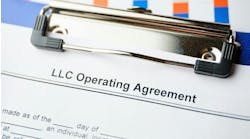by Mark Flinchum, Mark Leyden and Andy Manchir
After working hard to build a successful business, you want to see it live on after you hand over the reins to the company. Who knows your business better than you and your employees? This is why so many closely held businesses in construction and contracting choose an employee stock option ownership plan (ESOP) as a business succession strategy. It establishes an employee-owned company, and offers a flexible, tax-favorable way to exit the business, provide retirement benefits, and retain and motivate employees.
How It Works
“An ESOP comes to mind when family businesses or other closely held companies contemplate an exit strategy,” says Ron Lenz, CPA, CCIFP®, the Partner in charge of Katz, Sapper & Miller’s Construction Services Group in Indianapolis. “The current owners can stay involved while they and the employees recognize a number of tax-preferred financial benefits. Equally as important, clients—such as sizeable construction firms—are generally left unimpacted since there is a continuity of operations and culture.”
An ESOP is a tax-qualified retirement plan that can be used in conjunction with other qualified plans in which the funds of the plan are primarily invested in stock of the business sponsoring the plan. Instead of depositing cash into the employees’ accounts, the business allocates shares of company stock. The stock, which is expected to grow in value over time, is repurchased by the plan at the retirement of the employees. The employees benefit from the tax-deferred gains on the stock while it grows inside the plan.
Each year, the company makes annual contributions to fund the purchase of ESOP shares as well as to ensure the ESOP plan is funded so it may purchase the shares of departing employee shareholders when they retire or otherwise leave the business. This funding can be accomplished through cash or stock contributions from the company under a ”leveraged ESOP” strategy. The ESOP borrows from the company to initially purchase the shares. The annual ESOP contributions are tax deductible, effectively permitting the company to fund their ESOP with after-tax dollars.
If a company does not wish to use financing to fund the ESOP purchase, then the sellers can replace that capital with seller notes, warrants, or a combination of the two. A warrant often allows the seller to reduce the seller note interest rate and potentially increase the overall rate of return. This is beneficial for both parties, as the lower payment conserves cash flow at the company while the warrant(s) allow for the seller(s) to participate in the future growth of the company when exercised.
In order to value the price of company stock that is used to initially purchase the shares of the business and to document a fair market value of the stock on an on-going basis, the ESOP Trustee is required to have an independent appraisal performed at least annually.
“Warrants are an increasingly popular financial tool used in an ESOP transaction,” says Lenz who is a Certified Construction Industry Financial Professional (CCIFP) and often works with construction and contracting firms in establishing ESOPs. “A big plus the seller enjoys is that the return on the warrant is taxed at capital gains rates and not at ordinary rates.”
The Benefits
An ESOP is ideal for companies that are profitable, have a strong management team in place to takeover for the departing owner(s), and have an adequate payroll, number of employees, and a valuation to justify the plan. ESOPs provide a number of benefits for a company, its owners, and its employees:
- Helps provide job security for employees. According to the Employee Ownership Foundation, companies with employee stock ownership are 7.3 times less likely to lay off employees than conventionally owned firms.
- Provides a fair value market for the selling owner of a closely held company.
- Provides continuity for customers, who continue to interact with the same employees as they always have.
- Provides business continuity. Employees, who now have an increased focused on successfully carrying out their roles, stay in place to continue operating the business.
There is a notable tax benefit for the owners of businesses sponsoring an ESOP. Under federal tax law, owners of closely held companies can defer and possibly avoid tax on the capital gains incurred when selling stock to an ESOP when the following conditions are met:
- The ESOP company is a C corporation at the time of the sale.
- The ESOP owns at least 30% of the company immediately after the sale (The sale of stock by two or more shareholders counts toward this 30% requirement).
- The sale proceeds are reinvested in U.S. domestic corporation stocks and bonds within a set time period. To qualify, reinvestments must be made within a 15-month window that starts three months before the date of sale and ends 12 months after the date of the sale to the ESOP.
This “tax-free rollover”—which is included in the federal tax laws to encourage the establishment of ESOPs—can be very attractive to retiring owners and shareholders of closely held C corporations.
S corporations that sponsor an ESOP are eligible for a different tax incentive where the portion of the business owned by the ESOP trust is exempt from federal and often state income tax. For example, if 50% of an S corporation is owned by the ESOP, the business would avoid taxes on 50% of its income. A 100% ESOP-owned S corporation operates essentially free of federal income tax.
Midwest Mole, Inc., founded in 1982, is a specialty underground contractor and provides boring, trenchless tunneling, and directional drilling services. The Greenfield, Indiana-based company formed an ESOP in 2020. Retiring second-generation owner, Dan Liotti, reviewed several options for how to leave the company in a manner that it continued to be well-led and successful for years to come. “We wanted to find a way to continue to do business as usual going forward and to keep a ‘family feel’ to the company. That narrowed our options down to either a management buyout or an ESOP.”
Ultimately, Liotti chose an ESOP where he and Midwest Mole President Jason Miller sold their shares of company stock into the Plan. “The tax and cash-flow advantages of an ESOP are attractive, and we were able to do a stock sale instead of an asset sale and that made matters seamless with our existing contracts and other agreements,” says Liotti. “Now, as an employee-owned company, all the employees are personally invested in how the company performs. Working together, we will be able to continue the success of the company and carry Midwest Mole forward.”
The Role of Life Insurance
Establishing an ESOP is a significant step towards financial security for its owners and employees. The last thing you want to see is for its effectiveness to be derailed by unplanned or even planned events. There are a few long-term planning strategies you can implement to help protect your business, your employees, the integrity of the ESOP, and yourself.
Loan Protection
When a leveraged ESOP is chosen to help acquire a selling owner’s shares, a life insurance policy owned by the company can be used as collateral to secure the loan(s). A collateral assignment assures the lender that some or all of the death benefit proceeds will be applied to the loan balance. In addition, disability loan protection can be acquired to protect the company and the lender against an expected disability of an owner who is active in the business, or a key employee.
“There is an enhanced need for key person life insurance when a bank has financed the ESOP’s purchase of stock,” says Lenz. “The death of an individual critical to the company's success can place a big financial burden on an ESOP-owned company. Life insurance can help meet this liability, should it occur.”
Buy-Sell Planning
While many ESOPs own 100% of their sponsoring company, most do not and with those that do not, buy-sell planning is critical. Individual owners have several succession options:
· Sell to the ESOP at their death or retirement
· Buy one another out
· Have the company buy back their shares
Whatever the option chosen, making sure funding is available, through life and disability insurance, for the eventual buyout can assure that an unexpected death or disability does not disrupt the stability and growth of the company.
Business Protection
For most talented employees in contracting and construction, an ESOP can present both questions and opportunities.
· Will the business succeed under the new “generation” of management?
· Will the growth potential of the ESOP company’s value compensate employees for the inherent risk they take by having their qualified plan accounts largely invested in a single company?
· In addition to the stock ownership through the ESOP, are there other compensation plans that can appropriately reward and incentivize the management team, such as deferred compensation or synthetic equity?
These concerns can drive key employees from the company and potentially to the competition. Key employee benefits can help retain and reward them. Through the use of life insurance, deferred compensation plans, and executive bonus arrangements, you can keep key employees with the company and drive their performance through a promised benefit.
Repurchase Liability
Over time, the ESOP trust will be required to buy back the ownership shares held by the employees. This repurchase could be triggered by the employee’s departure, retirement, or reaching a specified age. For employees benefiting most from the ESOP—those who are most likely higher compensated key employees—this can be a significant expense for which a company must plan.
Some companies plan for the expense of share repurchase by establishing a sinking fund. Others turn to life insurance because it can cover unexpected buyout expenses triggered by death, as well as transfers during life. The ability to accumulate money tax-deferred makes life insurance an effective option to fund a lifetime buyout.
Income and Estate Tax Planning
A selling business owner may make a gradual transition out of the business or sell their interest all at once. Either way, an ESOP sale can trigger capital gains, requiring some personal planning. C corporation and S corporation company owners may face a potential estate tax liability and turn to life insurance to meet this obligation. By owning a policy inside of an irrevocable trust, a policy is kept outside of the business owner’s estate and the policy’s income tax-free death can provide the necessary liquidity to pay taxes.
It Is Your Decision
Whether you are prepared to sell your business in the near future or plan to work for a few more years, establishing a robust succession plan should be a priority. An ESOP may not be the exit strategy best suited for your company, but it is one you should evaluate and consider in coordination with your professional advisors.
Mark Flinchum is the partner-in-charge of Katz, Sapper & Miller’s ESOP Services Group. Mark counsels clients on the unique opportunities and potential tax benefits of creating an ESOP, and provides guidance throughout the many stages of an ESOP transaction.
Mark Leyden has been in the industry for 35 years. He founded Mark Leyden & Associates in 2007 and is an owner in Lion Street, a national network of 200 firms providing financial services. Leyden & Associates is an Indianapolis-based firm specializing in assisting businesses and families in the acquisition and management of life insurance assets.
Andy Manchir is a director in Katz, Sapper & Miller’s Valuation and ESOP Services Groups. Andy helps clients understand the value of their business and advises them on succession planning options, including ESOP, third-party sales, or family transitions.


